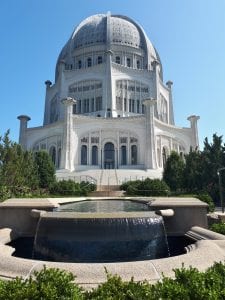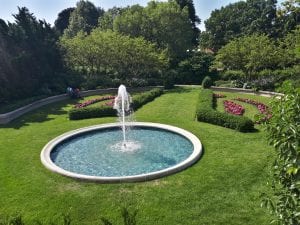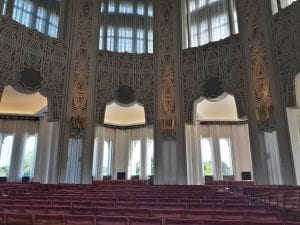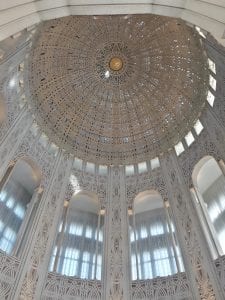An introduction: many call me Bam(s), and I am one participant of Arryman Program here, at Northwestern University. This is only my first three weeks in the US. Yes, I haven’t been in the states. But, I am not going to talk about my first impression or experience or culture shock in this post. Maybe in another one. So follow this blog! *wink wink
In this post, I would like to share with you about my recent trip to the Baha’i Temple.
About three weeks ago, my friends talked about the Baha’i faith as we passed a sign written Baha’i temple. I just discreetly listened to them as I knew nothing about the faith. Nonetheless, I still had no idea what it is. And today, I was invited to a little trip to Baha’i Temple.
Baha’i faith appears to be a new stream of “religion”. Its history can be traced back as early as the 1800s, when Mirza Husayn-Ali, known as Baha’u’llah found it in Persia. He was believed to be the latest Messenger of God.
Practising and disseminating the Baha’i faith was not easy. Many believed that Mirza’s teachings were devious. The Persian and Turkish governments, then, exiled him. He was banished to the prison-city of Acre in Palestine in 1868. He passed in 1892.
A year after Mirza passed, the Baha’i was introduced at the World Parliament of Religions in Chicago, USA. To date, the Baha’i faith has more than 150,000 followers living across the US.
Unlike other popular religions, Baha’i has no clergy. Instead, the faith has elected councils at local, national and international levels who administer the religious affairs. In the US, the Baha’i National Centre is located in Evanston. Yes, a city that becomes my new home.
The Baha’i Temple in Evanston, IL
It was quite easy to get to Baha’i Temple. We just took a purple line heading to Linden and got out at the final stop. Afterwards, we walked around seven to ten minutes following the indication provided.
The temple is so very beautiful. It is surrounded by green and well-maintained gardens (I don’t know how much they spend on the gardens only, let alone the building). The good weather today helped a lot with enhancing the view. Maybe I am a little bit bias here as I love the green scenery. But, the temple seems lush with many green areas covering the majority of its land.
One garden at the Baha’i Temple
One may question what the temple is. The temple is basically open for public. It is used for anyone to contemplate and pray according to their own belief. And because it is designed and dedicated for so doing, one must keep his/her noise level at zero level. Well, you can whisper still tho. There is no sermon or whatsoever related. Instead, they usually do some reading about deity.
Inside the Baha’i Temple
The interior of the Baha’i Temple is mostly filled with red chairs as shown in the picture above. The arrangement is quite simple actually. It is like a classroom if I may say. But, there are a bunch of red chairs situated behind a podium. Perhaps, it is where the elected councils sit during a praying. It is just my guess. I didn’t get a chance to ask that question today.
Part of the architecture remains of a mosque. The temple has high ceiling and tonnes of natural light and doors. In the middle of the ceiling, an Arabic caligraphy imprinted (see picture below).
The high ceiling with the Arabic caligraphy
During my visit, I had a chance to talk with, perhaps, one worshipper, real quick. It has come to my understanding that Baha’i faith seems to acknowledge different religious practices and doesn’t impose its believers to follow certain religious practices. It seems so versatile and open as a “religion”. Afterall, the Baha’i is a unique religious teaching which, still, little do I know.
In case you are interested in learning more about the Baha’i faith, just follow this link.
Please write your thought about the Baha’i faith in the comment section below. That’d be nice to learn together, wouldn’t it? 😉



